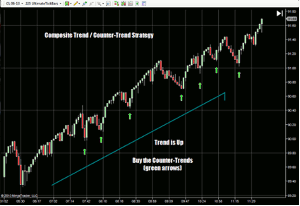One of the biggest keys to successful trading is the way we manage our trades, writes Rob Mitchell of MarketTradersJournal.com.
There are many different ways to trade and each is more becoming to any given personality and account size. You can buy or sell for longer-term benefit such as a, buy-and-hold kind of approach, you can swing trade by trying to catch intermediate-term cycles in the market. Then, you can go down into the intraday time frames where you can intraday trend trade, or counter trend trade. You can take even a shorter outlook by scalping for small amounts inside the micro cycles that make up each of the above larger cycles. In this article, we will focus on intraday or day trading time frames where trading is active and can be a lot of fun.
Each of these different trading styles has an impact on what kinds of risks you are exposing yourself to and your level of patience. Other factors come into play such as which market you decide to trade. If you want to trade intraday for trends, then a market like crude oil is quite the mover. Crude oil is a fast-moving market so large changes can happen very fast; often $700-$1,000 per contract moves can occur in as little as five minutes. If you like things a bit slower, you can go to the Russell futures or the E-mini S&P futures markets. There are, of course many other markets you can trade as well, including stocks and forex markets. The key is to make sure there is good liquidity and tight bid-ask spreads so it is possible to get good execution and a fairly low cost of doing business.
The same goes for intraday counter-trend trading. Counter-trend trading is where you take positions against the larger trend with the intent of "catching a bottom" (or top) for example. Counter trend and trend trading each have different profiles of win/loss ratio and average win to loss. For example, a counter-trend strategy may have a high win percentage with the losers being smaller when compared to winning trades. In trend-oriented approaches, the win percent is often lower but you may tend to get caught in trades that are many times the losers. This shifting of statistics from one profile of trading to another is a key factor you will want to consider when you are a trader regardless of the time frame you trade on (intraday or day).
NEXT PAGE: Buy the Dips
|pagebreak|Trend trading has certain inherent advantages that stack things in your favor from a statistical standpoint, but psychologically it is easier to counter-trend trade as this style of trading has the idea of "getting a deal" behind it, whereas trend trading may often involve buying at new highs or selling new lows; something that can be uncomfortable to do. As a result, traders are lured into counter-trend trading and are often not aware of how this impacts their overall statistical profile. This can lead to a difficult psychological situation for the trader. Either way, if you are aware where you stand as you trade and the likely impact of the bigger picture, the result you get is more likely to be in line with your expectations and success should be easier for you.
Why does trend trading have a statistical advantage over counter-trend trading? Because markets tend to have non-normal distributions of price movement. In other words, the market will often move further than most people expect in any given direction. So, if you trend trade, you can get caught in some really big trades. This can almost never happen in counter-trend trading because that trend resumes and you have to exit the position. This all adds up to an inherent advantage for trend-related traders.
Now, since most of us like to get a deal (or at least feel we are getting a deal), it is in fact possible to blend these two strategies into one. This can be done by trying to hop on a trend while the market is moving in the opposite direction. So, you are trend trading with the strategy of entering in the counter-trend moves. This can have the effect of potentially lowering risk and increasing reward potential.
On the chart below we can see an example of this market by the green arrows. Here we are going with the trend but we "buy the dips."
Can we stack things even more in our favor here? Yes, One of the biggest keys to successful trading is the way we manage the trade. If we scale out portions of our position as the market goes our way, we can stack things in our favor to some extent. This strategy works because as the market goes higher, as in the case above, booking profits reduces risk for the remaining position and makes it easier to "let the winners run."
These two strategies, money management and using a composite trend/counter-trend approach can help to stack things in your favor. With a little adjustment most traders can find a variation on this theme that can work well for them.
By Rob Mitchell of MarketTradersJournal.com





















